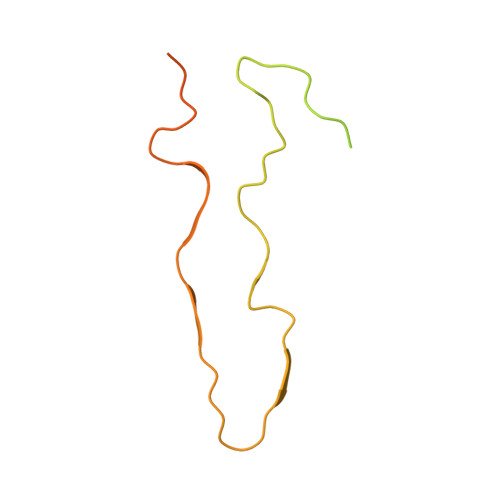Cryo-EM structures of the D290V mutant of the hnRNPA2 low-complexity domain suggests how D290V affects phase separation and aggregation.
Lu, J., Ge, P., Sawaya, M.R., Hughes, M.P., Boyer, D.R., Cao, Q., Abskharon, R., Cascio, D., Tayeb-Fligelman, E., Eisenberg, D.S.(2023) J Biological Chem 300: 105531-105531
- PubMed: 38072051
- DOI: https://doi.org/10.1016/j.jbc.2023.105531
- Primary Citation of Related Structures:
8DU2, 8DUW, 8EC7 - PubMed Abstract:
Heterogeneous nuclear ribonucleoprotein A2 (hnRNPA2) is a human ribonucleoprotein that transports RNA to designated locations for translation via its ability to phase separate. Its mutated form, D290V, is implicated in multisystem proteinopathy known to afflict two families, mainly with myopathy and Paget's disease of bone. Here, we investigate this mutant form of hnRNPA2 by determining cryo-EM structures of the recombinant D290V low complexity domain. We find that the mutant form of hnRNPA2 differs from the WT fibrils in four ways. In contrast to the WT fibrils, the PY-nuclear localization signals in the fibril cores of all three mutant polymorphs are less accessible to chaperones. Also, the mutant fibrils are more stable than WT fibrils as judged by phase separation, thermal stability, and energetic calculations. Similar to other pathogenic amyloids, the mutant fibrils are polymorphic. Thus, these structures offer evidence to explain how a D-to-V missense mutation diverts the assembly of reversible, functional amyloid-like fibrils into the assembly of pathogenic amyloid, and may shed light on analogous conversions occurring in other ribonucleoproteins that lead to neurological diseases such as amyotrophic lateral sclerosis and frontotemporal dementia.
- Departments of Chemistry and Biochemistry and Biological Chemistry, University of California, Los Angeles, Los Angeles, California, USA; UCLA-DOE Institute, Molecular Biology Institute, Howard Hughes Medical Institute, Los Angeles, California, USA.
Organizational Affiliation:
















